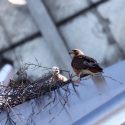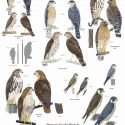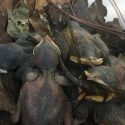 Photo ©
Keith Williams
Photo ©
Keith Williams

Community Project Helps Hawks
Did you know that raptors are common victims of rat poisoning? In our latest blog post, Katie Leung and Sunny Corrao of New York City Parks’ Wildlife Unit explain how volunteers are helping to reduce secondary poisoning of birds of prey. Citizen scientists in the Big Apple are contributing nesting observations of raptors to NestWatch, which in turn helps city officials determine where to suspend the use of rodenticides. This is a great example of NestWatch data feeding back into the local community to make a difference for birds.
Read on to learn more, and find out how you can get involved if you live in NYC.

New Poster Helps ID Hawks and Falcons
Having trouble identifying hawks and falcons, and interested in counting birds this winter? Sign up for Project FeederWatch before the end of September to receive this brand new poster in your kit: Common Backyard Hawks and Falcons of North America, illustrated by Jessica French! Sign up by calling 866-989-2473 or join online.

Can We #BringBirdsBack?
A study published last week in the journal Science reveals that since 1970, bird populations in the United States and Canada have declined by 29 percent, or almost 3 billion birds, signaling a widespread ecological crisis. The findings show that of nearly 3 billion birds lost, 90 percent belong to 12 bird families, including sparrows, warblers, finches, and swallows—common, widespread species that play influential roles in food webs and ecosystem functioning, from seed dispersal to pest control.
Yet amid the bad news, the study also documents a few promising rebounds resulting from galvanized human efforts. For example, raptors such as the Bald Eagle have made spectacular comebacks since the 1970s, after the harmful pesticide DDT was banned and recovery efforts through endangered species legislation in the U.S. and Canada provided critical protection.
This study was made possible by contributions of citizen scientists over 50 years, as well as 10 years of weather radar data which detects birds on migration. Please read the full story to get actionable tips that you can use to help #BringBirdsBack.

Bulk Uploads Abound
This month we bulk-uploaded 1,428 nest records into NestWatch! Of these, 790 were Purple Martin nest records from Pennsylvania. This data set spanned 12 years (2007-2018). We thank Henry Glick for collecting the data, and Jon Kauffman of Shaver’s Creek Environmental Center for making the data available digitally. The remaining 638 nest records were from nest boxes in the Bay Area of California, courtesy of longtime NestWatcher Lee Pauser.
We accept large data sets year-round of any species, including those not in nest boxes. Contact us if you have nesting data that you’d like to permanently archive with NestWatch.

Support NestWatch
We still have nesting bird posters and egg mugs available as a “thank you” for your donation to NestWatch. Your support fuels our science on nesting birds. So far this year, we have been able to prepare three scientific papers for publication and present results at two scientific conferences!